Large-Scale Fire Tests of Battery Electric Vehicle (BEV): Slovak Case Study
Abstract
:1. Introduction
- A positive electrode made of an intercalation material that has the ability to bind lithium ions.
- Negative electrode, made of a porous type of carbon.
- A separator that separates the positive and negative electrodes.
- The electrolyte, the role of which is to ensure the transfer of charge (ion) between the electrodes.
| Parameters | LIB Cathode Material | ||||
|---|---|---|---|---|---|
| Abbreviation/designation | LFP | LMO | LCO | NCM | NCA |
| Formula | LiFePO4 | LiMn2O4 | LiCoO2 | Li(NixCoyMnz)O2 | LiNi0.8Co0.15Al0.05O2 |
| Average voltage (V) | 3.2 (working range 2.5–3.65) | 3.7 (range 3–4.2) | 3.7 (range 3–4.2) | 3.6 (range 3–4.2) | 3.6 |
| Specific capacity * (mAh.g−1) | 130–140 | 100–120 | 135–150 | 160–220 | 180_200 |
| Cyclical life *, (100% DoD) | 2000–5000 1000–2000 | 300–700 500–2000 | 500–1000 | 800–2000 1000–2000 | 800–2000 |
| Safety performance * | excellent | good | low | low | low |
| Specific energy (Wh.kg−1) | 90–120 | 100–150 | 150–200 | 150–220 | 200–260 |
| Charging current (C) | 0.7–1 | 0.7–1 | 0.7–1 | 0.7–1 | 1 |
| Discharge current (C) | 1 | 1 | 1 | 1 | 1 |
| Application | Loads requiring high current and endurance. | Medical devices, electric drives. | Mobile phones, tablets, laptops. | Electric bicycles, healthcare, industry. | Healthcare, electric drives. |
| Comment | Safety, increased self-discharge. | High performance, safer than LCO. | High specific energy, high price Co. | High capacity and performance. | Similar properties to LCO. |
| Parameters | Membrane Composition of the Separator | ||||
|---|---|---|---|---|---|
| PE | PP | PP/PE/PP | PVDF | PE/PVDF | |
| Temperature of thermal degradation (°C) | 130–133 | 156–163 | 134–135 | ||
| Melting point (°C) | 139 | 162 | 165 | ||
| Thickness (μm) | 20 | 25–26 | |||
- In the second type, separator defects (due to heat-induced shrinkage or mechanical damage) create short circuits in the battery and rapid discharge of the energy stored in it [26], accompanied by unwanted chemical chain reactions and the release of enormous amounts of heat.
- The third type is electrical abuse [27]. Electrolyte decomposition occurs at the cathode interface, especially at a high state of charge (SOC). This leads to the accumulation of heat and the subsequent release of oxygen from the cathode and damage to the separator.
- The fifth type occurs when the battery is mechanically damaged, resulting in a short circuit and/or air infiltration into the battery [30].
2. Materials and Methods
2.1. Description of Samples–BEV with Lithium-Ion Cells
2.2. Preparation and Course of the Experiment
- Thermocouple T3 (marked in blue) measured the temperature at a height of 30 cm above the BEV and at 50 cm from the red thermocouples (Figure 2a).
2.3. The Course of the Experiment
3. Results
3.1. Results of BEV Large-Scale Fire Test 1
3.2. Results of BEV Large-Scale Fire Test 2
- The experiment was initiated on the second opening of the same EV traction battery, and a larger amount of released heat could already have been accumulated in the internal volume.
4. Discussion
5. Conclusions
- A mechanically damaged BEV (with intentionally made holes in the steel casing) could be initiated by an external initiator to the stage of a developed fire.
- An external 300 kW propane burner with a maximum power of 54 kW and a length of 54 cm, inserted directly into the battery pack, was initiated in fire test BEV 1 after 25 min. Fire test BEV 2 had a faster course of initiation due to the accumulation of flammable gases in the BEV.
- In both tests, a temperature above 1000 °C was reached. In the first test, the temperature reached 1056.9 °C just 2 min after the initiation. In the second test, the abovementioned process was repeated, and the maximum temperature reached was 1028 °C.
- When extinguishing the fire test BEV with foam, the temperature on thermocouple T1 (distance was 10 cm from the BEV surface) dropped from 486.1 °C to 76 °C after 10 s of application.
Author Contributions
Funding
Institutional Review Board Statement
Informed Consent Statement
Data Availability Statement
Conflicts of Interest
References
- Chen, Y.; Kang, Y.; Zhao, Y.; Wang, L.; Liu, J.; Li, Y.; Liang, Z.; He, X.; Li, X.; Tavajohi, N.; et al. A review of Lithium-Ion Battery Safety Concerns: The Issues, Strategies, and Testing Standards. J. Energy Chem. 2021, 59, 83–99. [Google Scholar] [CrossRef]
- Denios. Available online: https://www.denios.sk/servis/denios-know-how/sprievodca-bezpecnym-skladovanim-li-ion-baterii (accessed on 4 January 2024). (In Slovak).
- Batterie Spit Pulsa 800. Safety Data Sheet. Available online: https://www.itw.cz/file/EP/CS-FDS-Batterie-Li-Ion-P800.pdf (accessed on 8 January 2024). (In Czech).
- Electrend. Available online: https://legrand.sk/electrend/elektroinstalacie/ake-trendy-prinasa-akumulacia-elektrickej-energie/ (accessed on 8 January 2024). (In Slovak).
- Liu, K.; Liu, Y.; Lin, D.; Pei, A.; Cui, Y. Materials for lithium-ion battery safety. Sci. Adv. 2018, 4, eaas9820. [Google Scholar] [CrossRef] [PubMed]
- Liu, X.; Ren, D.S.; Hsu, H.J.; Feng, X.N.; Xu, G.L.; Zhuang, M.H.; Gao, H.; Lu, L.G.; Han, X.B.; Chu, Z.Y.; et al. Thermal Runaway of Lithium-Ion Batteries without Internal Short Circuit. Joule 2018, 2, 2047–2064. [Google Scholar] [CrossRef]
- Zhu, L.; Yan, T.-F.; Jia, D.; Wang, Y.; Wu, Q.; Gu, H.-T.; Wu, Y.-M.; Tang, W.-P. LiFePO4-Coated LiNi0.5Co0.2Mn0.3O2 Cathode Materials with Improved High Voltage Electrochemical Performance and Enhanced Safety for Lithium Ion Pouch Cells. J. Electrochem. Soc. 2019, 166, A5437. [Google Scholar] [CrossRef]
- Abe, Y.; Sawa, K.; Tomioka, M.; Watanabe, R.; Yodose, T.; Kumagai, S. Electrochemical performance of LiNi1/3Co1/3Mn1/3O2 cathode recovered from pyrolysis residue of waste Li-ion batteries. J. Electroanal. Chem. 2022, 922, 116761. [Google Scholar] [CrossRef]
- Bak, S.; Hu, E.; Zhou, Y.; Yu, X.; Senanayake, S.D.; Cho, S. Structural Changes and Thermal Stability of Charged LiNixMnyCozO2 Cathode Materials Studied by Combined in situ time-resolved XRD and Mass Spectroscopy. ACS Appl. Mater. Interfaces 2014, 6, 22594–22601. [Google Scholar] [CrossRef] [PubMed]
- Liang, C.P.; Kong, F.; Longo, R.C.; KC, S.; Kim, J.-S.; Jeon, S.; Choi, S.; Cho, K. Unraveling the Origin of Instability in Ni-rich LiNi1−2xCoxMnxO2 (NCM) Cathode Materials. J. Phys. Chem. C 2016, 120, 6383–6393. [Google Scholar] [CrossRef]
- Vilhelm, O. Composite Electrode Materials for Lithium-ion Batteries Based on LiFePO4. Diploma Ph.D. Thesis, Brno University of Technology, Faculty of Electrical Engineering and Communication, Brno, Czech Republic, 2011. (In Czech). [Google Scholar]
- Vavrus, B. New Trends in Stationary Battery Storage for a Family House. Bachelor‘s Thesis, Brno University of Technology, Faculty of Electrical Engineering and Communication, Brno, Czech Republic, 2018. (In Czech). [Google Scholar]
- Belharouak, I.; Lu, W.; Liu, J.; Vissers, D.; Amine, K. Thermal Behavior of Delithiated Li(Ni0.8Co0.15Al0.05)O2 and Li1.1(Ni1/3Co1/3Mn1/3)0.9O2 Powders. J. Power Sources 2007, 174, 905–909. [Google Scholar] [CrossRef]
- Cathode NCM 532. Safety Data Sheet. Available online: https://www.neicorporation.com/msds/NANOMYTE_BE-52E_NMC532_tape_SDS.pdf (accessed on 10 January 2024).
- Targray. NMC Battery Material. Available online: https://www.targray.com/li-ion-battery/cathode-materials/nmc (accessed on 10 January 2024).
- Chung, Y.S.; Yoo, S.H.; Kim, C.K. Enhancement of Meltdown Temperature of the Polyethylene Lithium-ion Battery Separator via Surface Coating with Polymers Having High Thermal Resistance. Ind. Eng. Chem. Res. 2009, 48, 4346–4351. [Google Scholar] [CrossRef]
- Orendorff, C.J. The role of Separators in Lithium-Ion Cell Safety. Electrochem. Soc. Interface 2012, 21, 61–65. [Google Scholar] [CrossRef]
- Wang, Q.S.; Sun, J.H. Enhancing the Safety of Lithium Ion Batteries by 4-isopropyl phenyl diphenyl phosphate. Mater. Lett. 2007, 61, 3338–3340. [Google Scholar] [CrossRef]
- Luo, L.; Gao, Z.; Zheng, Z.; Zhang, J. “Polymer-in-Ceramic” Membrane for Thermally Safe Separator Applications. ACS Omega 2022, 7, 35727–35734. [Google Scholar] [CrossRef] [PubMed]
- Kang, Y.; Liang, Z.; Zhao, Y.; Xu, H.; Qian, K.; He, X.; Li, T.; Li, J. Large-scale Synthesis of Lithium- and Manganese-rich Materials with Uniform Thin-film Al2O3 Coating for Stable Cathode Cycling. Sci. China Mater. 2020, 63, 1683–1692. [Google Scholar] [CrossRef]
- Shahid, S.; Agelin-Chaab, M. A review of thermal runaway prevention and mitigation strategies for lithium-ion batteries. Energy Convers. Manag. 2022, X, 100310. [Google Scholar] [CrossRef]
- Electrochemical Safety Research Institute. What is Thermal Runaway? Available online: https://ul.org/research/electrochemical-safety/getting-started-electrochemical-safety/what-thermal-runaway (accessed on 25 March 2024).
- Zhao, C.; Wang, T.; Huang, Z.; Wu, J.; Zhou, H.; Ma, M.; Xu, J.; Wang, Z.; Li, H.; Sun, J.; et al. Experimental study on thermal runaway of fully charged and overcharged lithium-ion batteries under adiabatic and side-heating test. J. Energy Storage 2021, 38, 102519. [Google Scholar] [CrossRef]
- Mallick, S.; Gayen, D. Thermal behavior and thermal runaway propagation in lithium-ion battery systems—A critical review. J. Energy Storage 2023, 62, 106894. [Google Scholar] [CrossRef]
- Jung, R.; Metzger, M.; Maglia, F.; Stinner, C.; Gasteiger, A.H. Oxygen Release and Its Effect on the Cycling Stability of LiNix MnyCozO2 (NMC) Cathode Materials for Li-Ion Batteries. J. Electrochem. Soc. 2017, 164, 1361–1377. [Google Scholar] [CrossRef]
- Wang, J.; Hu, Z.; Yin, X.; Li, Y.; Huo, H.; Zhou, J.; Li, L. Alumina/Phenolphthalein Polyetherketone Ceramic Composite Polypropylene Separator Film for Lithium Ion Power Batteries. Electrochim. Acta 2015, 159, 61–65. [Google Scholar] [CrossRef]
- Ren, D.; Feng, X.; Lu, L.; Ouyang, M.; Zheng, S.; Li, J.; He, X. An Electrochemical-thermal Coupled Overcharge-to-thermal-runaway Model for Lithium Ion Battery. J. Power Sources 2017, 364, 328–340. [Google Scholar] [CrossRef]
- Tarascon, J.M.; Armand, M. Issues and Challenges Facing Rechargeable Lithium Batteries. Nature 2001, 414, 359–367. [Google Scholar] [CrossRef]
- Kim, S.H.; Choi, K.H.; Cho, S.J.; Park, J.S.; Cho, K.Y.; Lee, C.K.; Lee, S.B.; Shim, J.K.; Lee, S.Y. A Shape-deformable and Thermally Stable Solid-state Electrolyte Based on a Plastic Crystal Composite Polymer Electrolyte for Flexible/safer Lithium-Ion Batteries. J. Mater. Chem. A 2014, 2, 10854–10861. [Google Scholar] [CrossRef]
- Liu, B.; Jia, Y.; Yuan, C.; Wang, L.; Gao, X.; Yin, S.; Xu, J. Safety Issues and Mechanisms of Lithium-Ion Battery Cell upon Mechanical Abusive Loading: A review. Energy Storage Mater. 2020, 24, 85–112. [Google Scholar] [CrossRef]
- Feng, X.; Ouyang, M.; Liu, X.; Lu, L.; Xia, Y.; He, X. Thermal Runaway Mechanism of Lithium ion Battery for Electric Vehicles: A review. Energy Storage Mater. 2018, 10, 246–267. [Google Scholar] [CrossRef]
- Rieh, J.S. Devices and Applications. Compr. Semicond. Sci. Technol. 2011, 5, 1–51. [Google Scholar]
- Zhang, Z.J.; Ramadass, P.; Fang, W. 18—Safety of Lithium-Ion Batteries. In Lithium-Ion Batteries; Pistoia, G., Ed.; Elsevier: Amsterdam, The Netherlands, 2014; pp. 409–435. [Google Scholar]
- Ziebert, C.; Melcher, A.; Lei, B.; Zhao, W.; Rohde, M.; Seifert, H.J. Chapter Six—Electrochemical—Thermal Characterization and Thermal Modeling for Batteries. In Micro and Nano Technologies, Emerging Nanotechnologies in Rechargeable Energy Storage Systems; Rodriguez-Martinez, L.M., Omar, N., Eds.; Elsevier: Amsterdam, The Netherlands, 2017; pp. 195–229. [Google Scholar]
- Warner, J.T. Lithium-ion battery operation. In Lithium-Ion Battery Chemistries 2019; Chapter 3; Elsevier: Amsterdam, The Netherlands, 2019; pp. 43–78. [Google Scholar]
- Pfrang, A.; Kriston, A.; Ruiz, V.; Lebedeva, N.; di Persio, F. Chapter Eight—Safety of Rechargeable Energy Storage Systems with a focus on Li-ion Technology. In Micro and Nano Technologies, Emerging Nanotechnologies in Rechargeable Energy Storage Systems; Rodriguez-Martinez, L.M., Omar, N., Eds.; Elsevier: Amsterdam, The Netherlands, 2017; pp. 253–290. [Google Scholar]
- Ferg, E.E.; Schuldt, F.; Schmidt, J. The challenges of a Li-ion starter lighting and ignition battery: A review from cradle to grave. J. Power Sources 2019, 423, 380–403. [Google Scholar] [CrossRef]
- Gerlitz, E.; Greifenstein, M.; Kaiser, J.F.; Mayer, D.; Lanza, G.; Fleischer, J. Systematic Identification of Hazardous States and Approach for Condition Monitoring in the Context of Li-ion Battery Disassembly. Procedia CIRP 2022, 107, 308–313. [Google Scholar] [CrossRef]
- MacNeil, D.; Lougheed, G.; Lam, C.; Carbonneau, G.; Kroeker, R.; Edwards, D.; Tompkins, j. Electric Vehicle Fire Testing. In Proceedings of the 8th EVS-GTR Meeting, Washington, DC, USA, 1–5 June 2015. [Google Scholar]
- UL 2580, “Standard for Safety for Batteries for Use in Electric Vehicles,” 1st Edition. NREL U.S. Department of Energy, Office of Energy, Efficiency & Renewable Energy. October 13, 2011. Available online: https://www.nrel.gov/docs/fy13osti/54404.pdf (accessed on 1 November 2012).
- Kang, S.; Kwon, M.; Choi, J.Y.; Choi, S. Full-scale fire testing of battery electric vehicles. Appl. Energy 2023, 332, 120497. [Google Scholar] [CrossRef]
- Sturm, P.; Fo¨ßleitner, P.; Fruhwirt, D.; Galler, R.; Wenighofer, R.; Heindl, S.F.; Krausbar, S.; Hegerf, O. Fire tests with lithium-ion battery electric vehicles in road tunnels. Fire Saf. J. 2022, 134, 103695. [Google Scholar] [CrossRef]
- Cui, Y.; Cong, B.; Liu, J.; Qiu, M.; Han, X. Characteristics and Hazards of Plug-In Hybrid Electric Vehicle Fires Caused by Lithium-Ion Battery Packs With Thermal Runaway. Front. Energy Res. 2022, 10, 878035. [Google Scholar] [CrossRef]
- Hodges, J.L.; Salvi, U.; Kapahi, U. Design fire scenarios for hazard assessment of modern battery electric and internal combustion engine passenger vehicles. Fire Saf. J. 2024, 146, 104145. [Google Scholar]
- Lecocq, A.; Bertana, M.; Truchot, B.; Marlair, G. Comparison of the fire consequences of an electric vehicle and an internal combustion engine vehicle. In Proceedings of the International Conference on Fires in Vehicles-FIVE 2012, Chicago, IL, USA, 27–28 September 2012; Volume 2, pp. 183–194. [Google Scholar]
- Watanabe, N.; Sugawa, O.; Suwa, T.; Ogawa, Y.; Hiramatsu, M.; Tomonori, H.; Miyanoto, H.; Okamoto, K.; Honma, M. Comparison of fire behaviors of an electric-battery-powered vehicle and gasoline-powered vehicle in a real-scale fire test. In Proceedings of the 2nd International Conference on Fires in Vehicles-FIVE 2012, Chicago, IL, USA, 27–28 September 2012; pp. 195–206. [Google Scholar]
- Willstrand, O.; Bisschop, R.; Blomqvist, P.; Temple, A.; Anderson, J. Toxic Gases from Fire in Electric Vehicles; RISE Research Institutes of Sweden: Goteborg, Sweden, 2020.
- Hynynen, J.; Willstrand, O.; Blomqvist, P.; Andersson, P. Analysis of combustion gases from large-scale electric vehicle fire tests. Fire Saf. J. 2023, 139, 103829. [Google Scholar] [CrossRef]
- Jaguemont, J.; Bardé, F. A critical review of lithium-ion battery safety testing and standards. Appl. Therm. Eng. 2023, 231, 121014. [Google Scholar] [CrossRef]
- UL 9540A—Test Method for Evaluating Thermal Runaway Fire Propagation in Battery Energy Storage Systems, 2019. 3th Edition. NREL U.S. Department of Energy, Office of Energy, Efficiency & Renewable Energy. Available online: https://natron.energy/files/resources/natron-ul-9540a-cell-report-revised-july-8-2020-final.pdf (accessed on 8 July 2020).
- Voigt, S.; Sträubig, F.; Palis, S.; Kwade, A.; Knaust, C. Experimental comparison of Oxygen Consumption Calorimetry and Sensible Enthalpy Rise Approach for determining the heat release rate of large-scale lithium-ion battery fires. Fire Saf. J. 2021, 126, 103447. [Google Scholar] [CrossRef]
- Cui, Y.; Liu, J.; Cong, B.; Han, X.; Yin, S. Characterization and assessment of fire evolution process of electric vehicles placed in parallel. Process Saf. Environ. Prot. 2022, 166, 524–534. [Google Scholar] [CrossRef]
- Held, M.; Tuchschmid, M.; Zennegg, M.; Figi, R.; Schreiner, C.; Mellert, L.D.; Welte, U.; Kompatscher, M.; Hermann, M.; Nachef, L. Thermal runaway and fire of electric vehicle lithium-ion battery and contamination of infrastructure facility. Renew. Sustain. Energy Rev. 2022, 165, 112474. [Google Scholar] [CrossRef]
- Kvasha, A.; Gutiérrez, C.; Osa, U.; Meatza, I.; Blazquez, J.A.; Macicior, H.; Urdampilleta, J.I. A comparative study of thermal runaway of commercial lit hium ion cells. Energy 2018, 159, 547–557. [Google Scholar] [CrossRef]
- Meng, L.Y.; Wang, G.F.; See, K.W.; Wang, Y.P.; Zhang, Y.; Zang, C.Y.; Li, S.; Xie, B. Explosion characteristic of CH4–H2-Air mixtures vented by encapsulated large-scale Li-ion battery under thermal runaway. Energy 2023, 278 Pt A, 4376439. [Google Scholar] [CrossRef]
- Marková, I.; Tureková, I. Theory of Fire and Analysis of Products, 1st ed.; EDIS Press UNIZA: Žilina, Slovakia, 2022; 215p. (In Slovak) [Google Scholar]
- Zhang, Y.; Li, Q.; Zhou, H. Chapter 5—Heat Transfer Calculation in Furnaces. In Theory and Calculation of Heat Transfer in Furnaces; Zhang, Y., Li, Q., Zhou, H., Eds.; Academic Press: Cambridge, MA, USA, 2016; pp. 131–172. [Google Scholar]
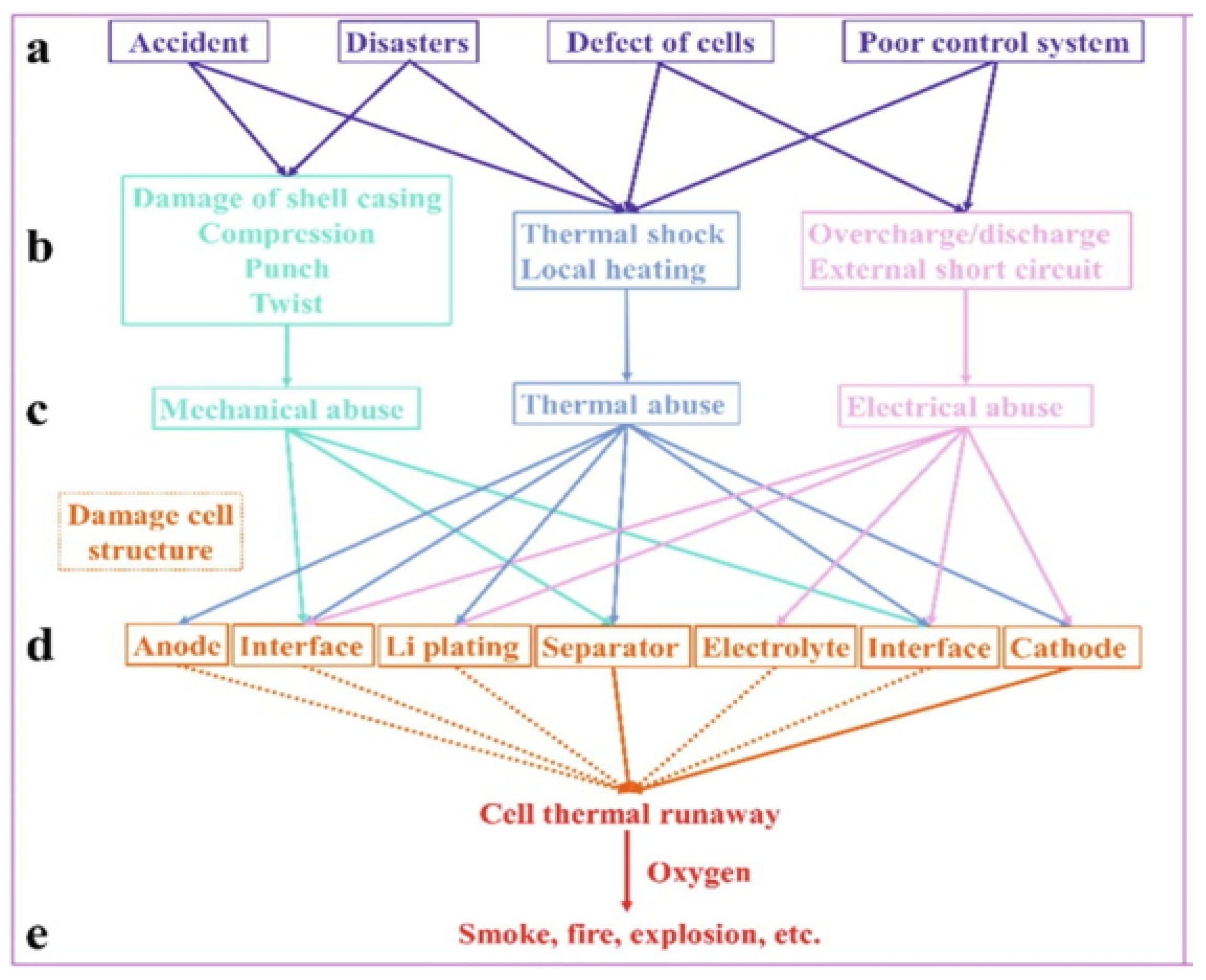

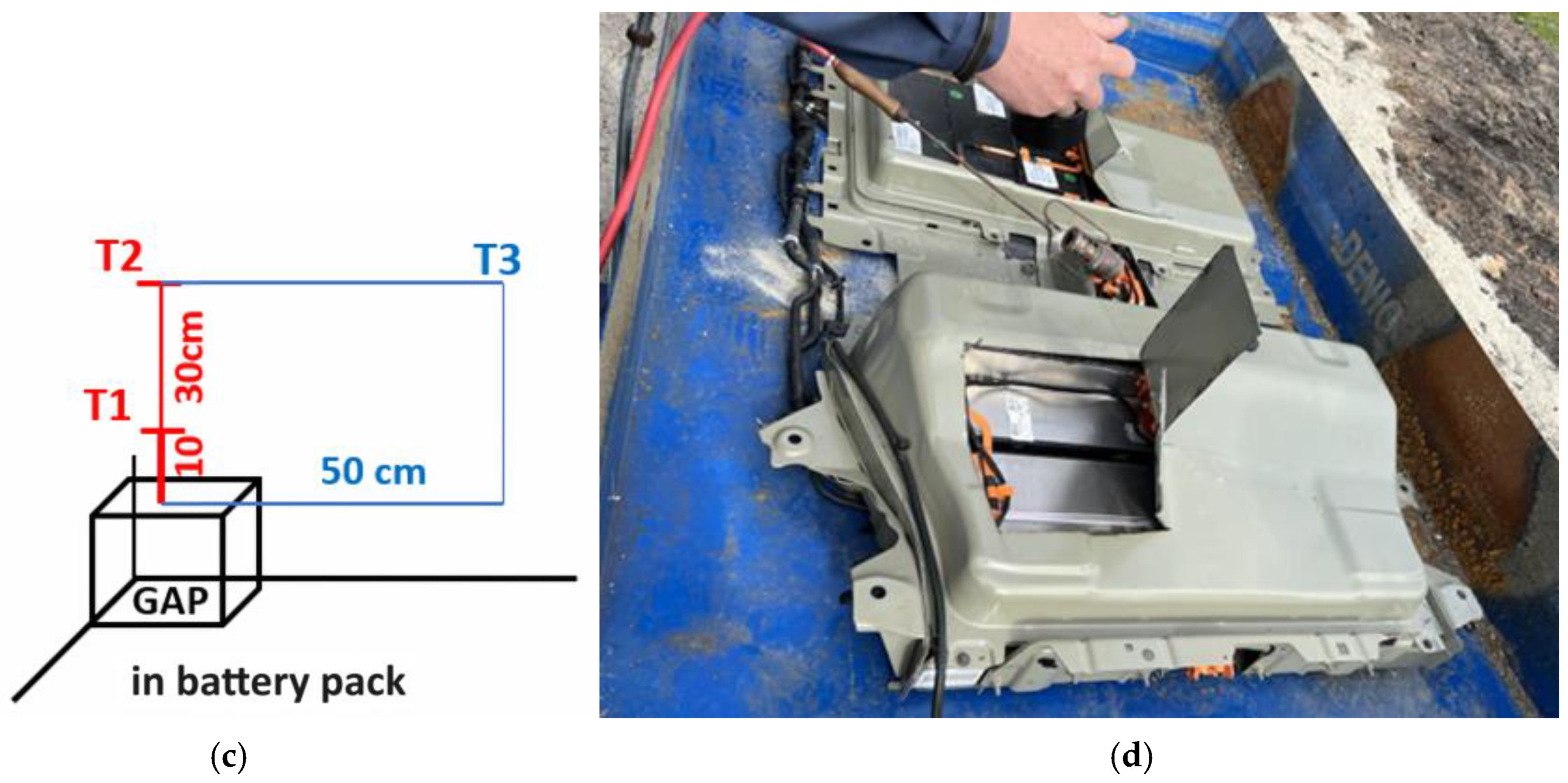
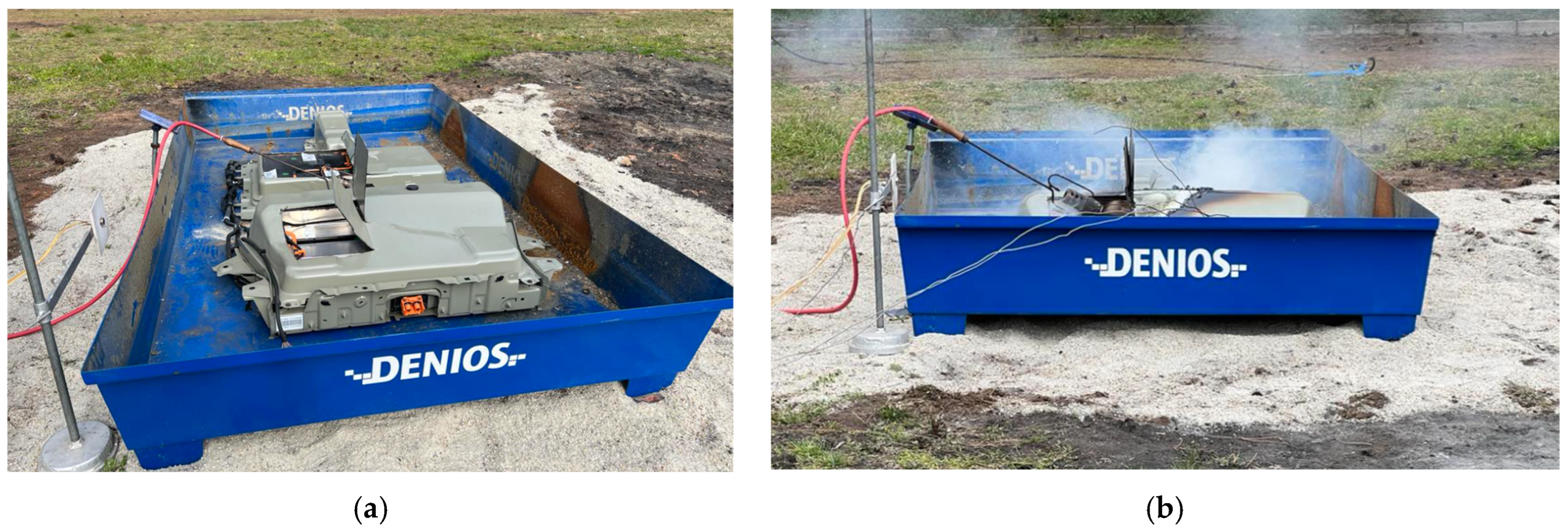
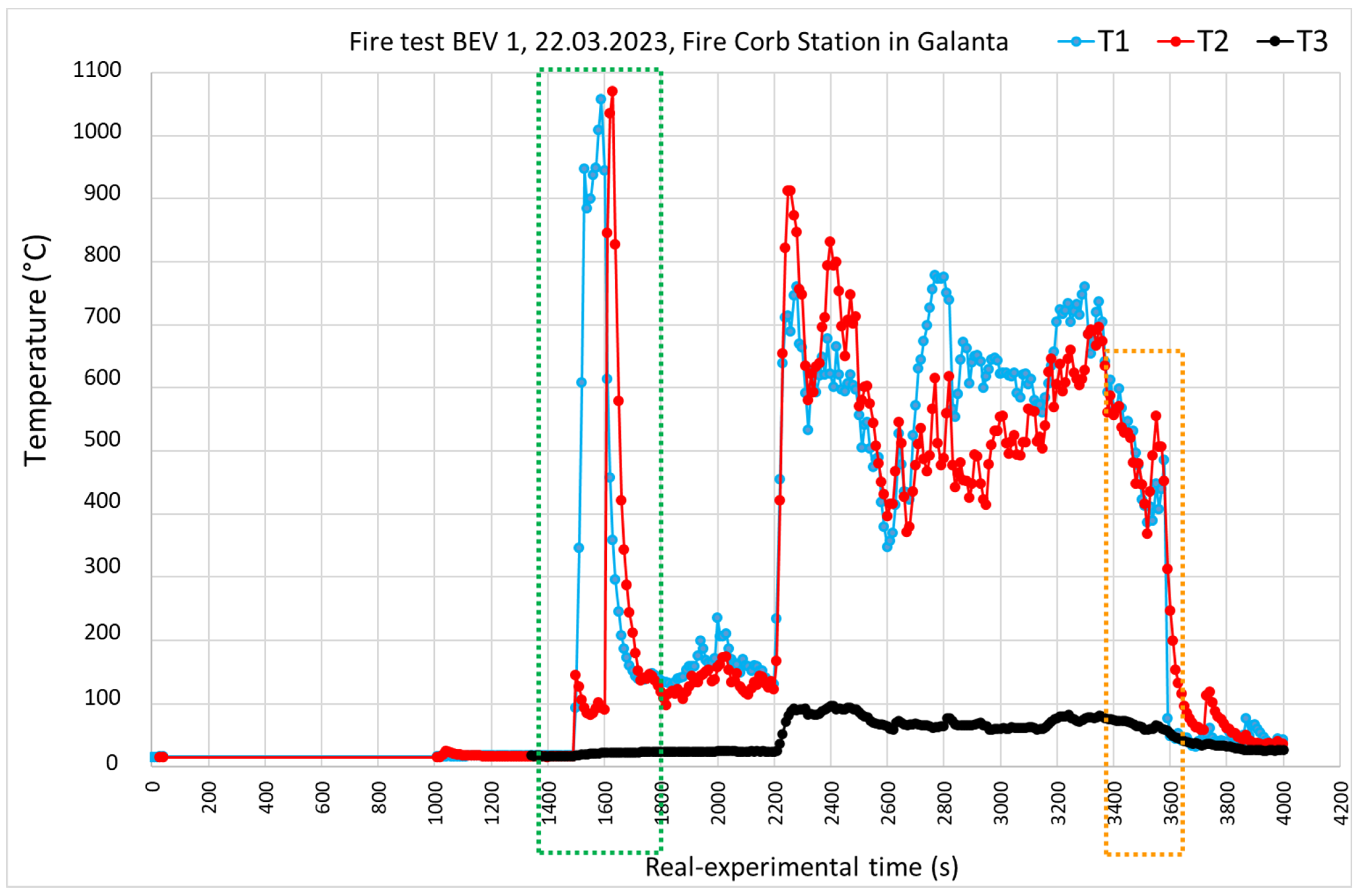

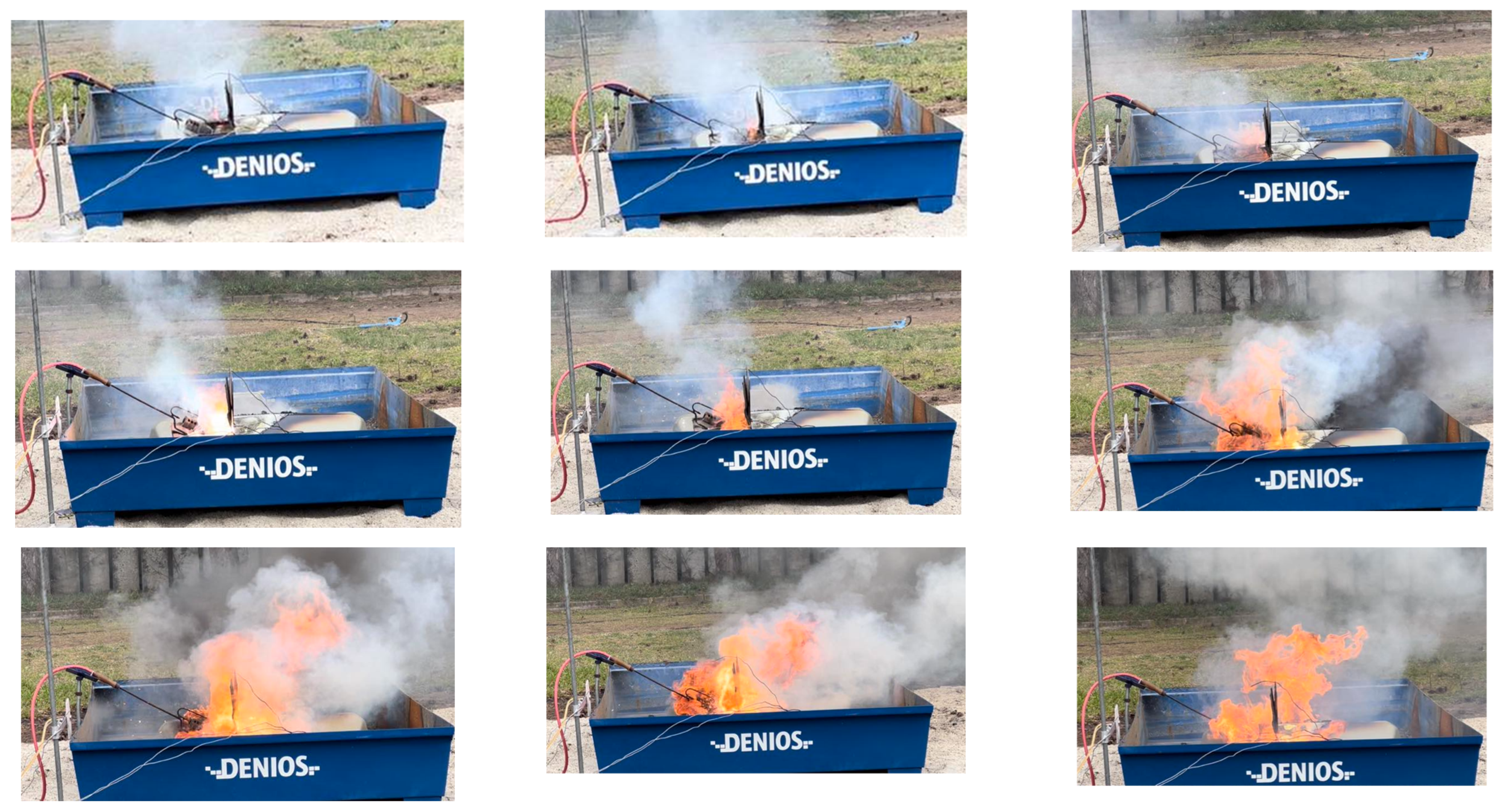

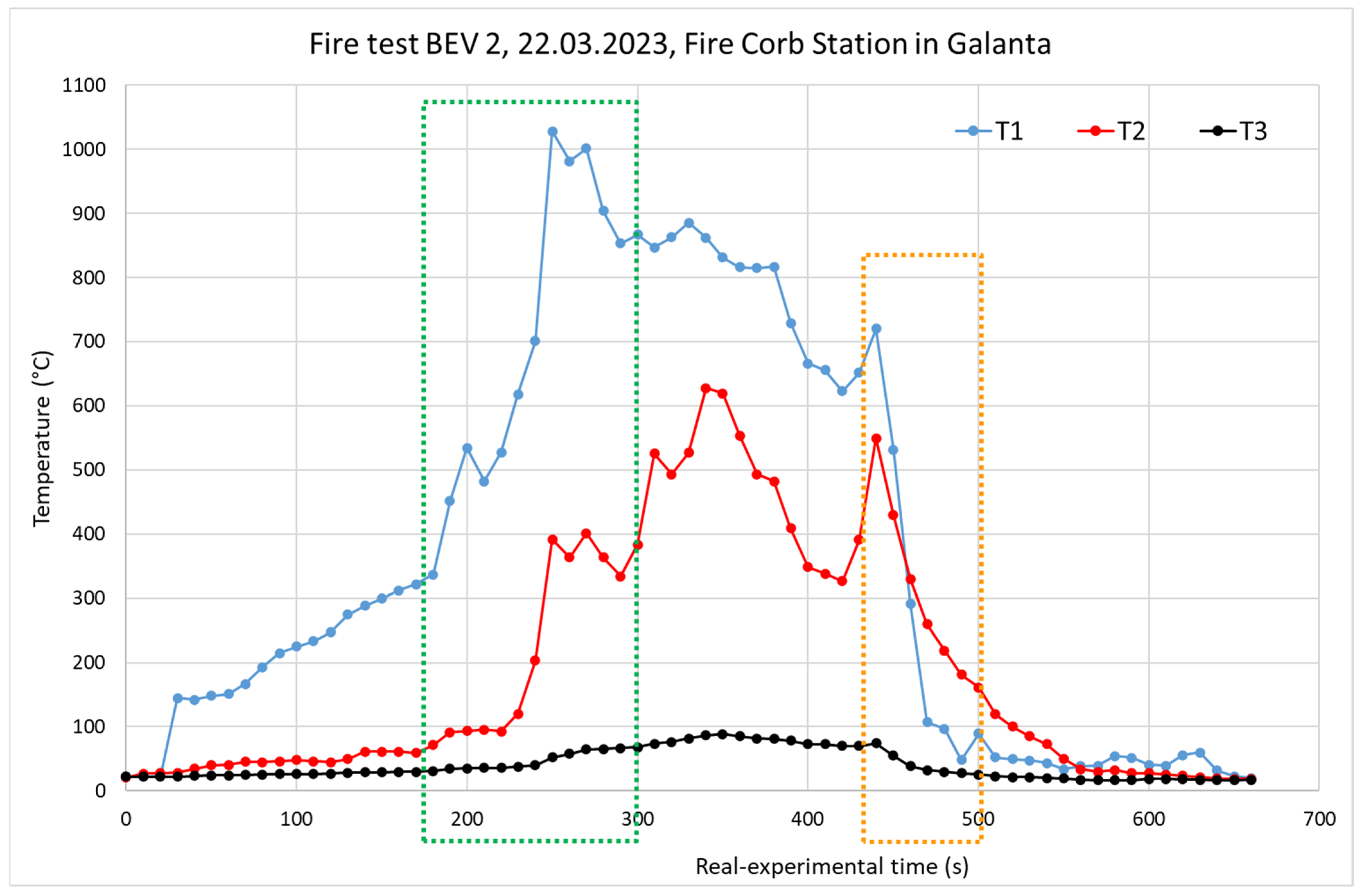
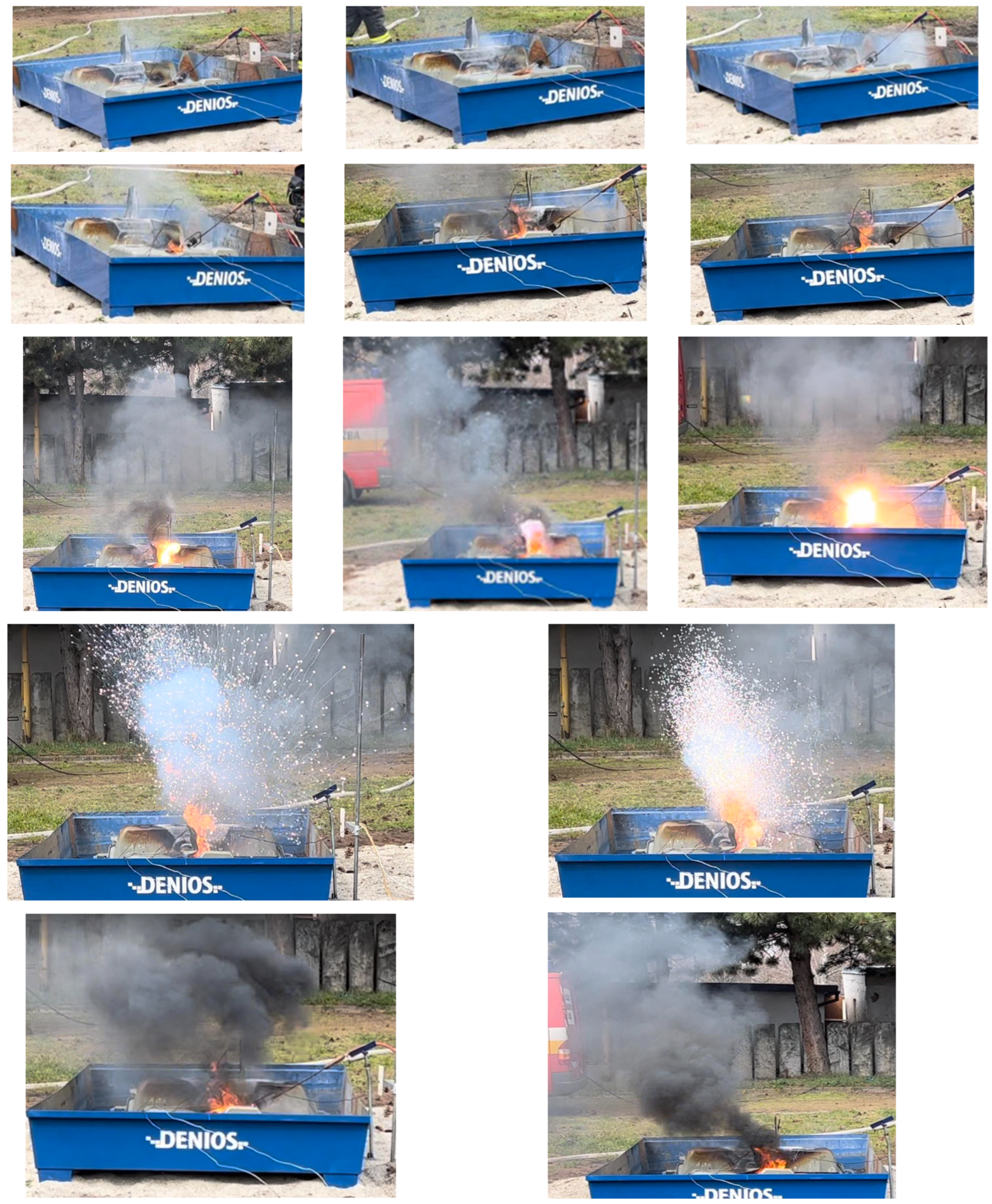
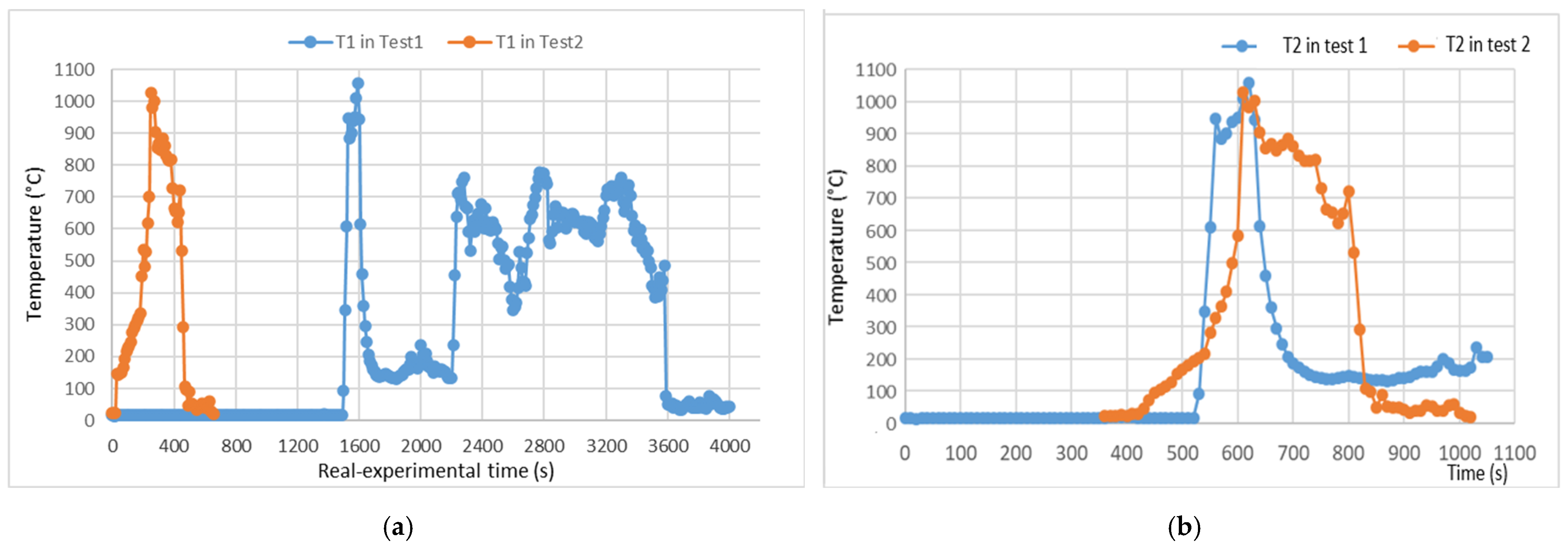

| LIB Construction | Chemical Composition | |||
|---|---|---|---|---|
| Element | Formula | CAS ** | ||
| Steel label | Steel | 65997-19-5 | ||
| Modul/cell | Cathode | Lithium Iron Phosphate (LFP) | LiFePO4 (LFP) | 15365-14-7 |
| NMC * | Li [M *]m[O]n | 346417-97-8 | ||
| The base of the cathode | Aluminum | Al | 7429-90-5 | |
| Anode | Carbon as graphite | C | 7440-44-0 | |
| Carbon (black) | C | 1333-86-4 | ||
| Copper | Cu | 7440-50-8 | ||
| Electrolyte | Organic solvents data | Ethylene Carbonate EC | C3H4O3 | 96-49-1 |
| Diethyl Carbonate DEC | 105-58-8 | |||
| Dimethyl Carbonate DMC | C3H6O3 | 616-38-6 | ||
| Ethyl Methyl Carbonate EMC | C4H8O3 | 623-53-0 | ||
| Ethylene Acetate EA | 96-49-1 | |||
| Propylene Carbonate PC | 108-32-7 | |||
| Lithium salt | Lithium Hexafluorophosphate | LiPF6 | 21324-40-3 | |
| Carboxymethyl Cellulose Sodium Salt | 9004-32-4 | |||
| Separator | Poly(vinylidene fluoride-co-hexafluoropropylene) | PVDF | 9011-17-0 | |
| Polyvinylidene difluoride | PVDF | 24937-79-9 | ||
| Styrene-Butadiene rubber | SBR | 96-49-1 | ||
| Poly(vinylidene fluoride-co-hexafluoropropylene) | PVDF | 9011-17-0 | ||
| Parameter | Ti Battery Pack |
|---|---|
| Number of modules in pack | 18 |
| Cell type | Prismatic, 3.7 V; 62 Ah; weight 0.95 kg |
| Cells per Module | 12 |
| Anode material | Graphite |
| Cathode material | LiNiMnCoO2; NMC (811 or 523) |
| Separator | Ceramic coated microporous polyolefin |
| Electrolyte | Organic carbonates |
| Conducting salt | LiPF6 |
| Nominal voltage | 400 V (3.68 V per cell) |
| Energy capacity pack | 51 kWh |
| Specific energy | 143 Wh/kg (pack); 228 Wh.kg−1 (Module) |
| SOC | Usable 94.3% |
| Monitored Parameters | Values |
|---|---|
| Ambient temperature (°C) | 23.5 |
| Pressure (kPa) | 101.3 |
| Humidity (%) | 56 |
| Wind velocity (km.h−1) | 0.35 |
Disclaimer/Publisher’s Note: The statements, opinions and data contained in all publications are solely those of the individual author(s) and contributor(s) and not of MDPI and/or the editor(s). MDPI and/or the editor(s) disclaim responsibility for any injury to people or property resulting from any ideas, methods, instructions or products referred to in the content. |
© 2024 by the authors. Licensee MDPI, Basel, Switzerland. This article is an open access article distributed under the terms and conditions of the Creative Commons Attribution (CC BY) license (https://creativecommons.org/licenses/by/4.0/).
Share and Cite
Svetlík, J.; Tancos, Z.; Tancos, P.; Markova, I.; Slastan, K. Large-Scale Fire Tests of Battery Electric Vehicle (BEV): Slovak Case Study. Appl. Sci. 2024, 14, 4013. https://doi.org/10.3390/app14104013
Svetlík J, Tancos Z, Tancos P, Markova I, Slastan K. Large-Scale Fire Tests of Battery Electric Vehicle (BEV): Slovak Case Study. Applied Sciences. 2024; 14(10):4013. https://doi.org/10.3390/app14104013
Chicago/Turabian StyleSvetlík, Jozef, Zoltan Tancos, Petr Tancos, Iveta Markova, and Kristian Slastan. 2024. "Large-Scale Fire Tests of Battery Electric Vehicle (BEV): Slovak Case Study" Applied Sciences 14, no. 10: 4013. https://doi.org/10.3390/app14104013






